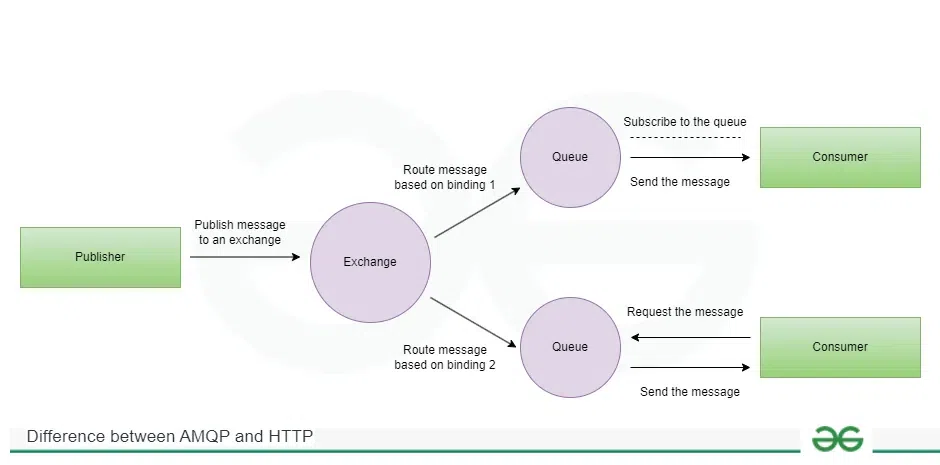Difference between AMQP and HTTP Protocols
Last Updated :
09 Apr, 2024
AMQP (Advanced Message Queuing Protocol) and HTTP (Hypertext Transfer Protocol) are two communication protocols used in distributed systems, however, they perform different functions and have different properties. In this article, we are going to discuss the differences between AMQP and HTTP protocols.
What is AMQP?
AMQP is an acronym used for the Advanced Message Queuing Protocol. It is a protocol that is used for communication between applications. It is a lightweight, protocol that supports the applications for data transfer. This protocol is used for its scalability and modularity with the technologies.

AMQP
Components of AMQP
- Exchanges: The exchange is responsible for fetching messages and properly arranging them in the appropriate queue
- Channel: A channel is a multiplexed virtual connection between AMQP peers that is built into an existing connection.
- Message Queue: It is a unique entity that connects messages to their resources or pointsBinding of origin.
- Binding: Bindings are a set of predetermined instructions for queuing and exchanging. It manages message transmission and delivery.
- Virtual Host: Vhost is a platform that provides isolation capabilities within the broker. Multiple vhosts may be functional at the same time, depending on the users and their access rights.
What is HTTP?
HTTP is an acronym used for Hypertext Transfer Protocol. It is a protocol that is used for communication between client and server. This protocol is responsible for the response from the server side to the client response. It is a base protocol for the communication of web services.

HTTP
Difference Between AMQP and HTTP
| Basis |
AMQP |
HTTP |
| Full Form |
Advanced Message Queuing Protocol. |
Hyper Text Markup Protocol. |
| Developed by |
It was developed by JPMorgan Chase. |
It was developed by Tim Berners-Lee. |
| Communication Nature |
It has asynchronous communication nature. |
It has synchronous communication nature. |
| Usage |
It is easy to setup and manage. |
It is user centric and it can be used in every aspect. |
| Message Delivery |
It has guaranteed message delivery. |
It has no guarantee for message delivery. |
| Interface |
It provides publish/subscribe interface. |
It provides point to point interface. |
| Fault Tolerance |
AMQP protocol can bear the server broke issue on its own. |
HTTP protocol is not capable to react to the server breakdown issue. |
| Segmentation |
It has the property of segmentation and can process messages into slots. |
It does not has this capability to treat each message as segments. |
| Protocol Characteristics |
It is specific protocol used for specific purposes. |
It is general purpose protocol and is used for multiple purposes. |
| Advantages |
It is fast, flexible and cost effective protocol. |
It is well known, efficient and multi-purpose protocol. |
Frequently Asked Question on AMQP and HTTP – FAQs
Why AMQP is faster than HTTP?
HTTP consumes four times more CPU than AMQP protocols. In conclusion, message-oriented protocols provide more stable and improved results than the REST model-based HTTP protocol for all evaluation conditions.
Which layer protocol is AMQP?
AMQP is an application layer protocol.
What are the benefits of AMQP?
- AMQP supports flexible message routing, such as point-to-point, publish-subscribe.
- AMQP supports encryption and authentication protocols such as TLS.
What are the key features of AMQP?
The AMQP’s distinctive features are message orientation, queuing, routing, dependability, and security. AMQP is mostly used for corporate messaging.
Like Article
Suggest improvement
Share your thoughts in the comments
Please Login to comment...